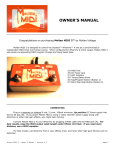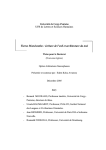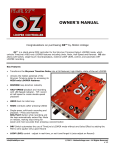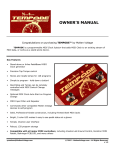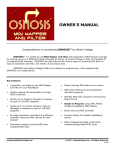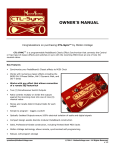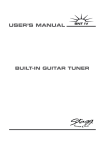Download OWNER`S MANUAL - Molten Voltage
Transcript
OWNER’S MANUAL Congratulations on purchasing Molten MIDI T™ by Molten Voltage Molten MIDI T is designed to control the Digitech™ Whammy™ DT. When configured for Whammy & Clock output, Molten MIDI T also sends corresponding MIDI Program Change and Song Select data to other MIDI devices. (A) MIDI Port (B) DC Power Jack (C) LED Indicator (D) Tempo/Select Knob (E) Tap/Program Button (Button 1) (F) Start Stop Step Button (Button 2) CONNECTING Plug in a separate or isolated 9 volt, 2.1mm, 100mA minimum, tip negative DC Power supply into the DC IN jack (B). If you power Molten MIDI T using a "daisy chained" power supply along with distortion or other high gain effects, you might hear clicking. Connect Molten MIDI T to your Whammy by plugging a MIDI cable into the MIDI jack (A). For best results, keep the MIDI output cable length under fifteen (15) feet. If you need more distance, use a MIDI repeater. For best results, use Whammy first in your effects chain, and never after high gain devices such as distortion. Molten MIDI T - Owner’s Manual - version 1.0 page 1 Molten MIDI T may be daisy chained to your Whammy via any other MIDI device with a MIDI Thru jack that re-transmits an exact copy of the data received at its MIDI In jack: Molten MIDI T > MIDI In > MIDI Thru > Whammy For more information on configuring your MIDI device to pass MIDI information thru to the Whammy, consult the manual for that device. PLAYBACK Molten MIDI T sends MIDI signals to the Whammy, and can change both the Setting (e.g. Octave Up) and the “virtual” position of the expression pedal. Whammy will stay in that "virtual" position unless you move the expression pedal, which will then override the "virtual" position. Molten MIDI T stores nineteen (19) user Programs at a time. Programs are selected using the Controls, as described below. Molten MIDI T comes pre-programmed with nineteen Programs to get you started. *** You MUST Set Whammy to “heel up, toe down” (pedal all the way forward) when using Step or Loop type programs to minimize Whammy tracking errors. *** NOTE: Molten MIDI T does NOT control the right side (Drop Tune) settings on the Whammy DT, but can be used with those settings. More info below. There are five different Program types: 1) Loop Portamento Loop Portamento programs cycle through sequences of “virtual” expression pedal positions at the chosen Duration using a single Base Setting. “Portamento” means you will hear Whammy slide from one step to the next as if you are moving the expression pedal, rather than jumping. * Note that portamento will automatically turn off and will not be heard if the playback speed is higher than the Portamento Rate will allow. 2) Loop, No Portamento Loop, No Portamento programs cycle through sequences of “virtual” expression pedal positions at the chosen Duration using a single Base Setting. As Molten MIDI T changes to a new “virtual” position, you will NOT hear Whammy “slide” to the new position. Instead, Whammy will “jump” from one “virtual” position to another (although the Whammy DT has a bit of portamento built in to every interval change). 3) Step Portamento Step Portamento programs step through sequences of “virtual” expression pedal positions each time you press Button 2 [Start/Stop/Step]. As Whammy changes to a new “virtual” position, you will hear it “slide” up or down to the new position, as if you are moving the expression pedal. 4) Step, No Portamento Step, No Portamento programs step through sequences of “virtual” expression pedal positions each time you press Button 2 [Start/Stop/Step]. As Whammy changes to a new “virtual” position, you will NOT Molten MIDI T - Owner’s Manual - version 1.0 page 2 hear it “slide” to the new position. Instead, Whammy will “jump” from one “virtual” position to another (although the Whammy DT has a bit of portamento built in to every interval change). 5) Different Settings Different Settings programs step sequentially through the selected Whammy settings each time you press Button 2 [Start/Stop/Step]. When using this type of Program, Molten MIDI T does not change the “virtual” position of the expression pedal. Instead, Molten MIDI will continue to use the previous position (whether “virtual” or not). This allows you to set the expression pedal to “toe down” and jump your solo up or down an octave or two with the touch of a button! There are two different Output Types: 1) Whammy Only (no MIDI Clock, Program Change, or Song Select information is sent) 2) Whammy & Clock (MIDI Clock information is sent in time with the Loop sequence. MIDI Program Change and Song Select information is sent each time a program is selected, as discussed below) Controls TAP/PGM [Button 1] The TAP/Program button (E) performs a number of functions. Tap Tempo While a Loop Program is playing, Button 1 can change the playback Duration. Set the Duration by tapping Button 1 twice (or any even number of taps). The time between the last two taps always corresponds to the length of time the entire sequence plays. Molten MIDI T changes the Duration “on the fly” without pausing the loop. In the Whammy Only mode, the new tempo starts right after the second tap. In Whammy & Clock mode, the new tempo starts when Molten MIDI T reaches the beginning of the sequence to keep everything synchronized. Program Select If no Loop program is running, pressing Button 1 puts Molten MIDI T into Program Select. In this Mode, the effect is turned off, and the “Shallow” and “Deep” detune LEDs flash along with the LED indicating the current Program. Program 1 is indicated by the top left (Octave Down/Up Harmony) LED. Program 2, the next LED down, and so on through 9. Program 10 is indicated by the lower right (Dive Bomb) LED. Program 11, by the next LED up, and so on through Program 19 (2 Octaves Up). Each subsequent press of Button 1 advances Molten MIDI T to the next Program. The Program is engaged by pressing Button 2 (discussed below). Because entering Program Select turns the effect off, Button 1 can also be used as an effect bypass switch when no Loop is running. Molten MIDI T - Owner’s Manual - version 1.0 page 3 START STOP STEP [Button 2] When a Loop Program is selected, alternate presses of Button 2 (F) start or stop playback of the sequence. Each time a Loop is stopped, it resets to the first step in the sequence. When a Step program is selected, pressing Button 2 advances Molten MIDI T to the next step in the sequence. If you press Button 1, Molten MIDI T will switch to Program Select which will bypass the effect. If you press Button 2 again, the Step program will start over at the first step in the sequence. When a Different Settings program is selected, pressing Button 2 advances Molten MIDI T to the next Whammy setting in the sequence. If you press Button 1, Molten MIDI T will switch to Program Select which will bypass the effect. If you press Button 2 again, the Different Settings program will start over at the first Whammy setting in the sequence. TEMPO/SELECT [Knob] Program Select If no Loop program is running, turning the Tempo/Select Knob (D) will put Molten MIDI T into Program Select. In this Mode, the effect is turned off, and the “Shallow” and “Deep” detune LEDs flash along with the LED indicating the current program. Rotating the Knob cycles Molten MIDI T through the nineteen programs. The desired program is engaged by pressing Button 2. Tempo Control While a Loop program is playing, the Knob can change the playback duration “on the fly”. The duration range is approximately 0.25 to 13 seconds. In the Whammy Only and Clock Only modes, the adjusted tempo is heard right away. In Whammy & Clock mode, the adjusted tempo is heard when Molten MIDI T reaches the beginning of the sequence to keep everything synchronized. LED Indicator Molten MIDI T uses a two-color Red/Yellow LED (C) to indicate status and playback tempo. When in Program Select, the LED glows solid red. When in Step or Different Settings mode, the LED glows solid yellow. Whammy Only When playing a Loop program in Whammy Only mode, the LED flashes Red at the beginning of the sequence. When paused, the LED flashes Yellow at the beginning of the sequence. Whammy & Clock When playing a Loop program in Whammy & Clock mode, the LED flashes Red at the beginning of the sequence. Molten MIDI T - Owner’s Manual - version 1.0 page 4 If the sequence is 2-4 steps, the LED only flashes Red. If the sequence is 5-8 steps, the LED flashes Red at the beginning of the sequence, then Yellow halfway through the sequence. If the sequence is 9-16 steps, the LED flashes Red at the beginning of the sequence, then Yellow ¼, ½ and ¾ of the way through the sequence. Note that if you use an odd number of steps in a sequence (anything other than 4, 8, or 16), the flashing will not correspond to the steps in the sequence, but instead to the MIDI Clock quarter note output, as discussed below. When paused, the Red flash is replaced with Yellow. During the two Programming modes, the LED flashes as discussed below. Using Molten MIDI T with the Drop Tune Settings Although Molten MIDI T does not control the right side Drop Tune settings on the Whammy DT, those settings can be used along with Molten MIDI T. Generally, the Drop Tune settings work as expected, but when using the 2 Octave Up setting, Whammy will limit the pitch range, and will drop the pitch output an octave when asked to create a pitch beyond its 2 octaves up limit. This is true even if you use the Whammy DT without Molten MIDI T. MIDI OUTPUT The default channel on which Molten MIDI T sends Whammy MIDI data is 15. Channel 16 is reserved for non-Whammy Program Change information. The default output setting for Molten MIDI T is Whammy Only. If you want to use the Whammy & Clock mode, you must change the mode as described in the next section. If you connect Molten MIDI T directly to your Whammy and use Whammy Only mode, you won’t have to change anything unless your Whammy has been changed from its stock MIDI receive setting of “OMNI”. To find out what MIDI Channel your Whammy is set to, DISCONNECT MOLTEN MIDI T, then hold down the Whammy’s button as you plug in the power (with your amp off!) and see what LED flashes. The “5th Up > 6th Up” LED indicates “OMNI”, which means your Whammy will receive MIDI data on all MIDI channels. If you need to change the MIDI channel, rotate the Whammy knob until the “5th Up > 6th Up” LED is flashing, then press the Whammy button again. Be careful not to move the expression pedal while you do this or you will need to re-calibrate your Whammy, as described in its User’s Guide. Whammy & Clock mode Because the default Output Type is Whammy Only, you will need to switch to Whammy & Clock mode to send MIDI Clock, MIDI Start, MIDI Stop, Program (Patch) Change, and Song Select information along with the Whammy data. To change the mode, either use the Programming Interface or follow this procedure: When powering Molten MIDI T on, hold down only Button 2. The LED will light red if Whammy Only mode, and yellow if Whammy & Clock mode. While holding Button 2, press Button 1 to toggle between the two modes. When you have selected the desired mode, release Button 2. When using Whammy & Clock mode, you MUST set your Whammy to MIDI channel 15, or whatever MIDI channel you have chosen using the computer-based Programming Utility. To find out what MIDI Channel your Whammy is set to, DISCONNECT MOLTEN MIDI T, then hold down the Molten MIDI T - Owner’s Manual - version 1.0 page 5 Whammy’s button as you plug in the power (with your amp 4th Up” LED indicates Channel 1. If you need to change the the desired LED is flashing, then press the Whammy button pedal while you do this or you will need to re-calibrate your off!) and see what LED flashes. The “3rd Up > MIDI channel, rotate the Whammy knob until again. Be careful not to move the expression Whammy, as described in its User’s Guide. In Whammy & Clock mode, Molten MIDI T simultaneously outputs Whammy and MIDI Clock data allowing you to synchronize your Loop programs to drum machines, sequencers, and other effects that use MIDI Clock data. Molten MIDI T outputs MIDI Clock data in time with the sequence while a Loop program is playing. ⇒ If the sequence is 2-4 steps, Molten MIDI T will send quarter-note MIDI Clock data once (1x) per sequence. ⇒ If the sequence is 5-8 steps, Molten MIDI T will send quarter-note MIDI Clock data twice (2x) per sequence. ⇒ If the sequence is 9-16 steps, Molten MIDI T will send quarter-note MIDI Clock data four times (4x) per sequence. As you can see, the same sequence Duration will result in different MIDI Clock tempos depending on the length of the Sequence. The tap timing also changes: with 2-4 steps - the tap time is equal to the quarter-note MIDI Clock output; with 5-8 steps, the tap time is half the speed of the quarter-note MIDI Clock output (the clock is 2x as fast as you tap); and with 9-16 steps, the tap time is ¼ the speed of the quarter-note MIDI Clock output (the clock is 4x as fast as you tap). Note that if you use an odd number of steps in a sequence (anything other than 4, 8, or 16), the sequence steps may not correspond to the MIDI Clock output, however, everything will always line up at the beginning of the Looping sequence. * MIDI devices cannot receive MIDI Clock information past a certain tempo. This tempo can easily be exceeded with a short duration and a 16-step sequence, so be sure to adjust your Duration accordingly. Molten MIDI T’s quarter-note output tempo, in beats per minute (bpm), can be calculated using the following equation: (60/Duration) * Number Of Steps = bpm Consult your device’s User’s Guide for more information, and download our Tempo Calculator at: http://www.moltenvoltage.com/downloads/Molten_MIDI_T_-_Tempo_Calculator.xls (requires Microsoft Excel) If you want to send just MIDI Clock information without any effect, select a Loop, No Portamento type Program with 4 Steps, and choose Octave Up as the Base Setting and set each Step (1-4) to Unison. The Duration you select will then be equivalent to the MIDI quarter note Duration. In Whammy & Clock mode, MIDI Program (Patch) Change and Song Select information are sent whenever Molten MIDI T is in Program Select and the Whammy program changes. Many MIDI devices both respond to, and display this information. The MIDI values for both Program Change and Song Select will always correspond to the value of the Whammy program, allowing you to synchronize your MIDI devices. Note that the literal MIDI value sent will be 0-18, however most MIDI devices will display these values as 1-19. Consult your particular device’s manual for more information. * MIDI Program (Patch) data is always sent on Channel 16 - which is always separate from the Whammy MIDI channel. If you want your MIDI device to receive this data, it must be set to receive Molten MIDI T - Owner’s Manual - version 1.0 page 6 Program data on MIDI Input Channel 16 and not OMNI. Consult your device’s User’s Guide for more information. MIDI Clock and MIDI Song Select information are types of MIDI System data that is not sent on any particular channel. Consult your device’s User’s Guide for more information on enabling and disabling its ability to receive and re-transmit such data. PROGRAMMING MANUAL PROGRAMMING It is strongly recommended that you read this section thoroughly before manually programming Molten MIDI T. A supplemental video demonstration of Manual Programming for Molten MIDI T can be viewed on this page: http://www.moltenvoltage.com/products/MOLTEN_MIDI_T_by_Molten_Voltage_-_Digitech_Whammy_DT_Controller.html How to Manually Program In either of the Whammy modes, Molten MIDI T can be manually programmed using the following steps: 1) Stop any Loop that is playing 2) Keep Molten MIDI T connected the Whammy 3) Press and hold Button 1 4) While holding Button 1, press Button 2 twice and hold it down. Release Button 1 BEFORE releasing Button 2. The effect will turn off and the Whammy’s “Shallow” LED will flash along with the LED indicating the currently-selected Program. If in Whammy & Clock mode, Molten MIDI T will also send MIDI Program Change values on Channel 16 along with corresponding Song Select data. 5) Rotate the Knob (D) to select the Program to overwrite. Press Button 2 to lock in your selection.* 6) The Whammy LEDs will then light up in a circular pattern, indicating that it is time to select the Program Type. Rotate the Knob briefly and LET GO to advance to the next Program Type. Repeat this procedure until the desired Program Type is indicated. The following flashing patterns are used to indicate the Program Types: Loop Portamento ~ LEDs light up in a circular pattern Loop, No Portamento ~ LEDs in a circular pattern, skipping every other one Step Portamento ~ LEDs go up and down the left side Step, No Portamento ~ LEDs go up and down the left side, skipping every other one Different Settings ~ LEDs go in a circle, lighting every 5th one Press Button 2 to lock in your selection.* Molten MIDI T - Owner’s Manual - version 1.0 page 7 7a) Loop or Step Program If a Loop or Step program is selected, the “Deep” LED will flash along with the LED corresponding to the Base Setting for the sequence (e.g. 2 Octaves Up). Turning the Knob will cycle Molten MIDI T through the various Base Settings (excluding Shallow and Deep detune). When the desired Base Setting is indicated, press Button 2 to lock it in.* The effect will then turn on, with the expression pedal “virtually” set to the “toe up, heel down” position. Rotating the Knob adjusts the “virtual” position of the expression pedal using a chromatic scale. Playing a note on your instrument will allow you to hear the shifted pitch. When the desired pitch is selected, press Button 2 to add that pitch to the sequence. The “Shallow” and “Deep” LEDs will briefly flash to let you know you have written that step of the sequence. Repeat this procedure until you have programmed the entire sequence (up to 16 steps).** When you have programmed all the steps you want, press Button 1.*** > Loop program ONLY Molten MIDI T will then begin playing back the sequence at a base Duration of 0.5 seconds for 2-4 steps, 1 second for 5-8 steps, and 2 seconds for 9-16 steps. If in Whammy & Clock mode, Molten MIDI T will also send MIDI Clock data, as described above. Use the Tempo Knob (D) to adjust the Duration of the sequence. Once you have obtained the desired duration, press Button 2. The “Shallow” and “Deep” LEDs will flash, along with the LED corresponding to the Program number, to let you know the new Program was successfully written. Molten MIDI T will exit Manual Programming mode and the new Program will begin playing. > Step program ONLY The “Shallow” and “Deep” LEDs will then flash, along with the LED corresponding to the Program number, to let you know the new Program was successfully written. Molten MIDI T will exit Manual Programming mode and Whammy will go to the first step of the new Program. 7b) Different Settings program If a Different Settings program is selected, the effect will then turn on. Turning the Knob will cycle Molten MIDI T through the various Whammy Settings, including one extra setting where the effect is off [look for the “Effect” LED to turn off while the “Shallow” LED is on]. Program the each setting by pressing Button 2 (up to 16 steps).** The “Shallow” and “Deep” LEDs will quickly flash along with the LED of the selected Setting to indicate that Setting has been added to the sequence.*** Select the next Setting by turning the Knob, and program it by pressing Button 2 again. When you have programmed all the Settings you want, press Button 1 to write the new Program. The “Shallow” and “Deep” LEDs will flash, along with the LED corresponding to the Program number, to let you know the new Program was successfully written. Molten MIDI T will exit Manual Programming mode and Whammy will be set to the first Setting of the new Program. Molten MIDI T - Owner’s Manual - version 1.0 page 8 * Pressing Button 1 at this point allows you to escape the Manual Programming routine. Escape is indicated by the Whammy flashing down the right side LEDs twice, then all the LEDs in a circle. After escaping, the effect will be off and Whammy will enter Program Select, flashing the currently selected Program. The previous Program is restored following an Escape. ** Note that any given Program is limited to a maximum of 16 steps. If you program a 16th step, Molten MIDI T will automatically begin playing the sequence back immediately after the 16th step has been programmed if its a Loop program, or will automatically write the new Program if its a Step or Different Settings program. *** If less than 2 steps have been programmed and Button 1 is pressed, you will escape the Manual Programming routine. Escape is indicated by the Whammy flashing down the right side LEDs twice, then all the LEDs in a circle. After escaping, the effect will be off and Whammy will enter Program Select, flashing the currently selected Program. The previous Program is restored following an Escape. COMPUTER-BASED PROGRAMMING Molten MIDI T may be programmed from your PC or Mac by connecting it to a compatible MIDI Interface Device with our exclusive Programming Utility. For a list of known compatible devices, please visit: http://www.moltenvoltage.com/products/MOLTEN_MIDI_T_by_Molten_Voltage_-_Digitech_Whammy_DT_Controller.html System requirements: ⇒ ⇒ Windows XP, Vista, 7, 8, or Mac OSX version 10.5 or later Attached MIDI Output Device that is built according to the Standard MIDI Specification. * Not all MIDI Interface Devices are built according to the Standard MIDI Specification, and some will not work. We sell one that works with both Mac and PC systems at kaom.com. Download the Programming Utility that is right for your system at: http://www.moltenvoltage.com/products/MOLTEN_MIDI_T_by_Molten_Voltage_-_Digitech_Whammy_DT_Controller.html Simple installation instructions are included on that page. Connecting 1) Stop all loops that are playing. 2) Remove the MIDI cable going into Molten MIDI T. Note that MOLTEN MIDI T must be connected to a DC power source to receive data from the Programming Utility. * Do NOT send the computer data through any other MIDI device, instead connect your computer’s MIDI “OUT” directly to Molten MIDI T. 3) Turn off all programs that are using your computer’s MIDI devices. With your computer’s MIDI output device installed, start the Programming Utility by double-clicking on it. Molten MIDI T - Owner’s Manual - version 1.0 page 9 The Molten MIDI T Programming Utility looks like this: 4) Plug the computer’s MIDI “OUT” into Molten MIDI T. When you connect a computer’s MIDI “OUT”, MMT flashes R-R-Y-Y :|| until it is stabilized, at which time it turns solid Yellow. You must wait until the flashing has stopped before sending MIDI data to Molten MIDI T. Following is a list of the various portions of the Programming Utility interface and their functions: (A) file OPEN Pressing “file OPEN” opens the most recent directory. Molten MIDI T’s default directory is in your computer’s Documents folder, as the sub-folder Molten MIDI T. Molten MIDI T uses a proprietary file system and .syx files. Click on the file you wish to open and hit “Open”. The file will then load into the interface at which time it may be edited. (B) file SAVE Pressing “file SAVE” opens the most recent directory. Molten MIDI T’s default directory is in your computer’s Documents folder in the sub-folder Molten MIDI T. Molten MIDI T - Owner’s Manual - version 1.0 page 10 The “file SAVE” dialog box allows you to rename the file by typing in a new one. Renaming the file has the same effect as a “Save As”. Once you have selected the file name, hit “Save”. (C) MIDI Device Selection Before hitting SEND, use the MIDI Device Selection pulldown menu to select the MIDI device that you have connected to Molten MIDI T. (D) SEND When you are ready to re-program Molten MIDI T, make sure the LED is solid Yellow, then press SEND. * Note that Molten MIDI T overwrites all 19 program when you hit SEND, not just the one currently selected by the interface. To restore factory defaults, download and SEND the file: Molten_MIDI_T_-_Factory_Presets.syx which is contained in the .zip file for the Programming Utility located at the bottom of this page: http://www.moltenvoltage.com/products/MOLTEN_MIDI_T_by_Molten_Voltage_-_Digitech_Whammy_DT_Controller.html (E) Program Number selection Use the Program Number selection pulldown menu to select the Program (1-19) you wish to edit. (F) Program Type selection Use the Program Type selection pulldown menu to select one of the 5 types of programs (described above) for the current Program (1-19). (G) Number of Steps selection Use the Number of Steps selection pulldown menu to select the number of Steps (2-16) for the current Program (1-19). Note that if you only want a single setting for a particular Program, simply use the same setting for Steps 1 and 2. When the number of Steps changes, the unavailable Step Values become grey and unusable (but still show their value). (H) Base Setting Use the Base Setting pulldown menu to select from among the nineteen Whammy settings for the current “Loop” or “Step” Program (1-15). When a "Different Settings" type program is selected, the Base Setting is ignored, and becomes grey and un-usable. * Note that Shallow and Deep Detune settings are not available Base Settings, but can be accessed as Step Values using a Different Settings type program. ** Note that whenever you switch to a different Base Setting for a particular Program, each of the Step Values is reset to the “Toe Up, Heel Down” value, and cannot be undone. For this reason, be sure to SAVE if you think you might change your mind. Molten MIDI T - Owner’s Manual - version 1.0 page 11 (I) Duration (sec) Use the Duration (sec) pulldown menu to select the length of the entire Loop sequence for the current Program (1-15). Once again, this value is NOT the duration of a particular Step, but the length, in seconds, of ALL the Steps of the Loop. Changing the Number of Steps will change the duration of each step, but not the overall length of the sequence. When a "Loop" type program is not selected, the Duration value is ignored and becomes grey and un-usable. * See above for information about how the MIDI Clock output relates to the Duration. (J) Step Values (1-16) Use the Step Value pulldown menus to select the value for each Step of the current Program (1-19). Please see below for a brief explanation of the musical theory behind the Loop and Step values. When using a “Different Settings” type program, the Step Values correspond to the Whammy’s 21 settings either On or Bypassed. (K) Whammy MIDI Base Channel Use the Whammy MIDI Base Channel pulldown menu to select MIDI Channel (1-15) on which the Whammy information will be sent. The default is Channel 1, and Channel 16 is reserved for Program Change messages. * Note that your Whammy MUST be set to the same channel to receive Molten MIDI T data. Refer to the MIDI OUTPUT section, above, for instructions on determining and changing your Whammy’s MIDI receive channel. ** Note that Whammy MIDI Base Channel is a global value that applies to all 19 Programs. (L) Output Type Use the Output Type pulldown menu to select Whammy Only or Whammy & Clock mode (discussed above). * Note that Output Type is a global value that applies to all 19 Programs. (M) Loop Portamento Speed Select Use the Loop Portamento Speed Select pulldown menu to select the speed (slow, medium, fast) of the portamento effect when a Loop is playing. “Portamento” means you will hear Whammy slide from one step to the next as if you are moving the expression pedal, rather than jumping. * Note that Loop Portamento Speed Select is a global value that applies to all 19 Programs. Molten MIDI T - Owner’s Manual - version 1.0 page 12 (N) Step Portamento Speed Select Use the Step Portamento Speed Select pulldown menu to select the speed (slow, medium, fast) of the portamento effect each time you step from Step Value to Step Value in a Step type program. “Portamento” means you will hear Whammy slide from one step to the next as if you are moving the expression pedal, rather than jumping. * Note that Step Portamento Speed Select is a global value that applies to all 19 Programs. Programming After you have designed all 19 programs, press “SEND”. The data will then be sent from your computer to Molten MIDI T. After you SEND the new programs, if successful, Molten MIDI T briefly flashes R-R-Y-Y :|| If unsuccessful, the LED turns solid red. Wait until Molten MIDI T stops flashing before removing your computer’s MIDI cable. Leave the power connected to Molten MIDI T, unplug your computer’s MIDI cable, and connect Molten MIDI T to the Whammy using a standard MIDI cable. It will take about 5 seconds to connect. * ALWAYS close the Programming Utility before disconnecting your computer-based MIDI device from your computer! If you connect Molten MIDI T to the Whammy without interrupting Molten MIDI T’s power, you will see a light show indicating whether it programmed successfully. If your program was successfully written, the Whammy LEDs will flash up each side until you press one of the buttons. After a press, Molten MIDI T will revert to Program Select. Fail Program If Molten MIDI T fails to program correctly, the original programs will be restored and the Whammy LEDs will flash randomly around until you either plug the USB MIDI cable back in, or press one of the buttons. After a press, Molten MIDI T will revert to Program Select. To try again, unplug the Whammy MIDI cable, remove then restore the power to Molten MIDI T, plug in your computer’s MIDI cable, and try again. MUSIC THEORY 101 Each fret on your guitar represents a half step. As an example, there are 12 half steps between the open E string and an octave up from there at the 12th fret. Scales based on half-steps are called a chromatic. All of the Step Values for the Loop and Step type programs are based on chromatic scales. Molten MIDI T’s interface was designed in consultation with professional musicians. They identified the following technical errors on the face of the Whammy: The 4th Down/3rd Down setting is mislabeled, and should have been 4th Down/flat 3rd Down. In addition, the values identified in the Step Value menus list the relative position as if they were an octave up, in order to stay consistent with the Step Values used in the Octave Down/Octave Up Harmony setting. Molten MIDI T - Owner’s Manual - version 1.0 page 13 The 5th Up/7th Up setting is mislabeled, and should have been 5th Up/flat 7th Up (although most musicians are talking about a flat 7th when they say “7th” or “Dominant 7th”, and a natural 7th when they say “Major 7th”). For this reason, the names of the Step Values used in connection with the 5th Up/7th Up Base Setting do not match the Whammy labeling. In order to stay consistent with the Step Values used in the Octave Down/Octave Up Harmony setting, the Step Values below Unison are identified as an octave below whatever value they would be if they were above Unison. For example, one step down (-2 half steps) is identified as “Flat 7th Octave Down”, rather than a “2nd Down”. When in doubt, just refer to the number of half steps listed on the Step Value. PROGRAMMING TIPS If you want a single setting on a “Step” type program, just choose Step Portamento and make a 2 step program that uses the same Step Value for each step. If you want a single Whammy setting on a “Different Settings” type program, just make a 2 step program that uses the same Step Value setting for each step. If you want to just send the MIDI Clock information without any effect while in Whammy & Clock mode, just use Loop, No Portamento with 4 Steps, and choose Octave Up as the Base Setting and set each Step (1-4) to Unison. The Duration you select will then be equivalent to the MIDI Quarter Note Duration. You can also make a sequence faster compared to the MIDI Clock by repeating the same step. In other words, a Sequence of 8 Steps with the same Step Value on every set of 2 steps (1,2...3, 4...5, 6...7, 8) will run twice as fast as that same sequence programmed using only 4 steps (1, 2, 3, 4). This is because the MIDI Clock output tempo changes relative to the number of steps, as discussed above. In addition, you can always program your drum machine or other MIDI device at some multiple of the Molten MIDI T tempo. If you like things really weird, when playing back a loop, you can manually switch the knob on the Whammy to any other setting and make some pretty kooky sounds. Note that stopping and restarting the Loop will reset the Whammy to its regular setting for that Program. STOCK PRESET PROGRAMS Molten MIDI T comes stock with the following programs: 1) Loop, No Portamento | Base Setting ~ Octave Down/Octave Up Harmony | 16 Steps Octave Down > Octave Down > Octave Down > Octave Down > Octave Down > Octave Down > Octave Down > Octave Down > Octave Up > 5th Up > 6th Up > Unison > 3rd Up > 3rd Up > Unison > Unison 2) Loop, No Portamento | Base Setting ~ Octave Down | 8 Steps Octave Down > Octave Down > Unison > Octave Down > Octave Down > Unison > 4th, Octave Down > Flat 7th, Octave Down Molten MIDI T - Owner’s Manual - version 1.0 page 14 3) Loop Portamento | Base Setting ~ Octave Down | 8 Steps Octave Down > Octave Down > Unison > Unison > Unison > Maj.7th, Octave Down > Flat 7th, Octave Down > 6th, Octave Down 4) Loop, No Portamento | Base Setting ~ Octave Up | 16 Steps Unison > Unison > Unison > Unison > Flat 5th Up > 5th Up > 4th Up > Flat 7th Up > Unison > Unison > Unison > Unison > Flat 7th Up > 5th Up > Flat 5th Up > 4th Up 5) Loop Portamento | Base Setting ~ Octave Up | 4 Steps Unison > 6th Up > Unison > Flat 7th Up 6) Loop, No Portamento | Base Setting ~ Octave Down/Octave Up Harmony | 4 Steps Unison > Octave Down > Unison > 5th Up 7) Step Portamento | Base Setting ~ Octave Up | 4 Steps Unison > 5th Up > Unison > Flat 7th Up 8) Step, No Portamento | Base Setting ~ 2nd Down | 2 Steps Unison > Maj. 7th, Octave Down (-1 half step) 9) Step Portamento | Base Setting ~Octave Down/Octave Up Harmony | 2 Steps 5th Up > Octave Up 10) Loop, No Portamento | Base Setting ~ Octave Down/Octave Up Harmony | 4 Steps Octave Up > Unison > Maj. 7th, Octave Down > Unison 11) Loop Portamento | Base Setting ~ Octave Down | 8 Steps Flat 7th, Octave Down > Unison > 6th, Octave Down > Unison > Flat 7th Octave Down > Unison > 6th, Octave Down > 6th Octave Down 12) Loop, No Portamento | Base Setting ~ 2 Octaves Up | 16 Steps Unison > Unison > Octave Up > 2 Octaves Up > Unison > Unison > Octave Up > Flat 7th Up > Unison > Unison > Octave Up > Octave + Maj. 7th Up > Unison > Unison > Octave Up > Octave + Flat 2nd Up 13) Loop, No Portamento | Base Setting ~ Octave Down/Octave Up Harmony | 16 Steps Octave Up > Octave Up > Octave Up > Unison > Octave Down > Octave Down > Octave Down > Unison > Unison > Unison > Unison > Octave Down > Unison > Octave Down > Octave Up > Octave Up 14) Different Settings | 2 Steps | Effect Off Shallow > Shallow Molten MIDI T - Owner’s Manual - version 1.0 page 15 15) Different Settings | 2 Steps | Effect On PUT EXPRESSION PEDAL FORWARD FOR BASS WHAMMY EMULATION (5TH - OCTAVE UP HARMONY) 4th Up/5th Up Harmony > Octave Down/Octave Up Harmony 16) Different Settings | 9 Steps | Effect Off Octave Down/Octave Up Harmony > 5th Down/4th Down Harmony > 4th Down/3rd Down Harmony > 5th Up/7th Up Harmony > 5th Up/6th Up Harmony > 4th Up/5th Up Harmony > 3rd Up/4th Up Harmony > Flat 3rd Up/3rd Up Harmony > 2nd Up/3rd Up Harmony 17) Different Settings | 10 Steps | Effect Off 2 Octaves Up > Octave Up > 5th Up > 4th Up > 2nd Down > 4th Down > 5th Down > Octave Down > 2 Octaves Down > Dive Bomb 18) Different Settings | 9 Steps | Effect On Octave Down/Octave Up Harmony > 5th Down/4th Down Harmony > 4th Down/3rd Down Harmony > 5th Up/7th Up Harmony > 5th Up/6th Up Harmony > 4th Up/5th Up Harmony > 3rd Up/4th Up Harmony > Flat 3rd Up/3rd Up Harmony > 2nd Up/3rd Up Harmony 19) Different Settings | 10 Steps | Effect On 2 Octaves Up > Octave Up > 5th Up > 4th Up > 2nd Down > 4th Down > 5th Down > Octave Down > 2 Octaves Down > Dive Bomb TROUBLESHOOTING Problem Molten MIDI T will not turn on. Solution Plug in 9 volt DC, 2,1mm Tip Negative Power Supply. Clicking or Noise Use a separate or isolated Power Supply for Molten MIDI T Use Whammy first in your chain, and never following high gain devices such as distortion. Whammy tracking problems * Set Whammy to “heel up, toe down” (treadle all the way forward) when using Step or Loop type programs to minimize Whammy tracking errors. Pickup signal strength can also affect Whammy tracking. Always turn the volume all the way up on your guitar. Single coils pickups also have more issues than humbuckers. If you hear glitches, the issue is with the Whammy rather than with Molten MIDI T. In our experience, single notes track much more consistently than chords. The Whammy DT also has more trouble tracking low notes such as bass guitar. Letting strings sustain can also create glitches. As the string loses its energy, its signal strength rapidly decreases and glitches may appear. Portamento loops are the most susceptible to glitches. If the tracking gets way off, mute the strings then play again. Whammy not receiving data sent Thru another MIDI device If Molten MIDI T is connected to Whammy thru another MIDI device (by connecting Molten MIDI T to that device’s MIDI IN, and Whammy to that device’s MIDI THRU), that device must be able to, and configured to, re-transmit MIDI all data, exactly as it is received at it’s MIDI IN port. Molten MIDI T - Owner’s Manual - version 1.0 page 16 Problem MIDI device is not receiving MIDI Clock Solution Put Molten MIDI T into Whammy & Clock or Clock Only mode using the computer-based Programming Utility. Make sure the MIDI device is configured to receive MIDI Clock. Consult the User’s Guide for that device. Start a Loop type program. MIDI device not receiving MIDI Program Change messages Put Molten MIDI T into Whammy & Clock mode using the computer-based Programming Utility. Set your MIDI device to receive MIDI Program Change messages on Channel 16. Whammy not flashing Make sure Whammy is set to receive MIDI on the same channel as Molten MIDI T is sending it. Please refer to the MIDI OUTPUT section, above. MIDI stops playing Check Power Supply connection. Replace MIDI cable with one under 10 feet. General Guidelines For best results, use Whammy first in your effects chain, and never after high gain devices such as distortion. Keep MIDI cables as short as possible. Long cables cause errors. If you need more length, consider using a MIDI repeater. If you are daisy chaining devices, the total cable length must be considered, as some MIDI devices do not amplify the signal. Warranty Molten Voltage is proud of its products and warrants this unit for a period of two (2) years from the date of purchase to be free from defects in materials and workmanship under normal use and service, as long as the unit is used with an approved power supply, and consistent with these instructions. Contact [email protected] regarding repairs. Any user repair attempts void the warranty. PROOF OF PURCHASE IS REQUIRED FOR WARRANTY REPAIRS. © 2013, Molten Voltage™. All Rights Reserved. Digitech and Whammy are trademarks of the Harmon Music Group Inc., Microsoft and Excel are trademarks of Microsoft Corporation. Neither of those companies or trademarks are in any way related to Molten Voltage. Molten MIDI T - Owner’s Manual - version 1.0 page 17


















